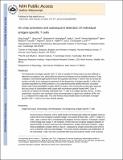| dc.contributor.author | Song, Qing | |
| dc.contributor.author | Han, Qing | |
| dc.contributor.author | Bradshaw, Elizabeth M. | |
| dc.contributor.author | Kent, Sally C. | |
| dc.contributor.author | Raddassi, Khadir | |
| dc.contributor.author | Nilsson, Bjorn | |
| dc.contributor.author | Nepom, Gerald T. | |
| dc.contributor.author | Hafler, David A. | |
| dc.contributor.author | Love, J. Christopher | |
| dc.date.accessioned | 2013-06-26T15:09:09Z | |
| dc.date.available | 2013-06-26T15:09:09Z | |
| dc.date.issued | 2009-12 | |
| dc.date.submitted | 2009-10 | |
| dc.identifier.issn | 0003-2700 | |
| dc.identifier.issn | 1520-6882 | |
| dc.identifier.uri | http://hdl.handle.net/1721.1/79369 | |
| dc.description.abstract | The frequencies of antigen-specific CD4+ T cells in samples of human tissue have been difficult to determine accurately ex vivo, particularly for autoimmune diseases such as multiple sclerosis or type 1 diabetes. Conventional approaches involve the expansion of primary T cells in vitro to increase the numbers of cells, and a subsequent assessment of the frequencies of antigen-specific T cells in the expanded population by limiting dilution or by using fluorescently labeled tetramers of peptide-loaded major histocompatibility complex (MHC) receptors. Here we describe an alternative approach that uses arrays of subnanoliter wells coated with recombinant peptide-loaded MHC class II monomers to isolate and stimulate individual CD4+ T cells in an antigen-specific manner. In these experiments, activation was monitored using microengraving to capture two cytokines (IFNγ and IL-17) released from single cells. This new method should enable direct enumeration of antigen-specific CD4+ T cells ex vivo from clinical samples. | en_US |
| dc.description.sponsorship | National Institute of Allergy and Infectious Diseases (U.S.) (Award Number 5U19AI050864-07) | en_US |
| dc.description.sponsorship | Juvenile Diabetes Research Foundation International | en_US |
| dc.description.sponsorship | Massachusetts Institute of Technology (Texaco- Mangelsdorf Career Development Professor) | en_US |
| dc.language.iso | en_US | |
| dc.publisher | American Chemical Society | en_US |
| dc.relation.isversionof | http://dx.doi.org/10.1021/ac9024363 | en_US |
| dc.rights | Article is made available in accordance with the publisher's policy and may be subject to US copyright law. Please refer to the publisher's site for terms of use. | en_US |
| dc.source | PMC | en_US |
| dc.title | On-Chip Activation and Subsequent Detection of Individual Antigen-Specific T Cells | en_US |
| dc.type | Article | en_US |
| dc.identifier.citation | Song, Qing, Qing Han, Elizabeth M. Bradshaw, Sally C. Kent, Khadir Raddassi, Björn Nilsson, Gerald T. Nepom, David A. Hafler, and J. Christopher Love. On-Chip Activation and Subsequent Detection of Individual Antigen-Specific T Cells. Analytical Chemistry 82, no. 2 (January 15, 2010): 473-477. | en_US |
| dc.contributor.department | Massachusetts Institute of Technology. Department of Chemical Engineering | en_US |
| dc.contributor.department | Massachusetts Institute of Technology. Department of Mechanical Engineering | en_US |
| dc.contributor.mitauthor | Song, Qing | en_US |
| dc.contributor.mitauthor | Han, Qing | en_US |
| dc.contributor.mitauthor | Love, Christopher J. | en_US |
| dc.relation.journal | Analytical Chemistry | en_US |
| dc.eprint.version | Author's final manuscript | en_US |
| dc.type.uri | http://purl.org/eprint/type/JournalArticle | en_US |
| eprint.status | http://purl.org/eprint/status/PeerReviewed | en_US |
| dspace.orderedauthors | Song, Qing; Han, Qing; Bradshaw, Elizabeth M.; Kent, Sally C.; Raddassi, Khadir; Nilsson, Björn; Nepom, Gerald T.; Hafler, David A.; Love, J. Christopher | en_US |
| dc.identifier.orcid | https://orcid.org/0000-0002-7989-2376 | |
| dspace.mitauthor.error | true | |
| mit.license | PUBLISHER_POLICY | en_US |
| mit.metadata.status | Complete | |
